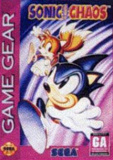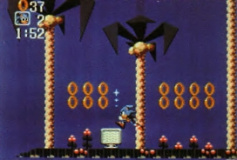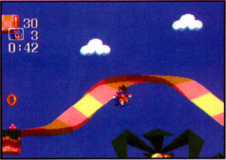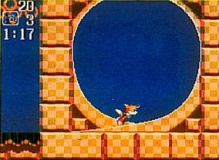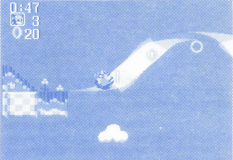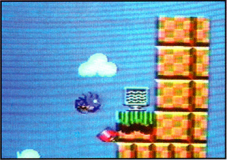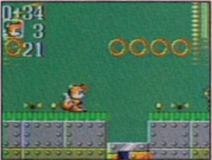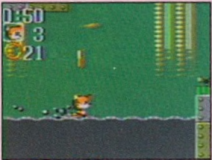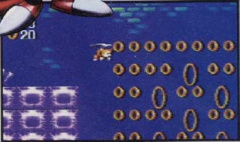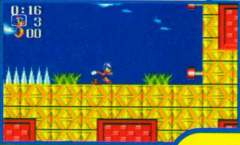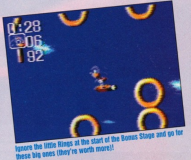Difference between revisions of "Sonic Chaos/Development"
From Sonic Retro
Chainspike (talk | contribs) (Some new screenshots.) |
|||
| (One intermediate revision by one other user not shown) | |||
| Line 1: | Line 1: | ||
{{back}} | {{back}} | ||
| + | ''[[Sonic Chaos]]'' had gone through several changes over its development process. There are several rejected ideas, level designs, and other things that were left on the cutting room floor. The following details several of these things. | ||
| − | '' | + | ==Development process== |
| + | ''Sonic Chaos'' spent much of its development being known as '''''Sonic the Hedgehog 3''''' (being a successor to the 8-bit version of ''[[Sonic the Hedgehog 2 (8-bit)|Sonic the Hedgehog 2]]''). Being developed again by [[Aspect]], it builds upon what was established in the previous outing, though with the addition of features from the [[Sega Mega Drive]] version of ''[[Sonic the Hedgehog 2 (16-bit)|Sonic 2]]'' and influence from ''[[Sonic the Hedgehog CD]]''. At some point a decision was made to re-brand the game, possibly to avoid confusion with the then-unannounced Mega Drive ''[[Sonic the Hedgehog 3]]'', which ''Chaos'' shares very little in common with. | ||
| − | The 8-bit ''Sonic 2'' was produced by a different team to its 16-bit counterpart, and while attempts were made towards the end to unify parts of the two games' design (such as putting more of an emphasis on Tails, despite the character not being playable), it is said to be based more off the original ''[[Sonic the Hedgehog (16-bit)|Sonic the Hedgehog]]'' than its sequel. ''Chaos'' aimed to address this, by not only making Tails playable, but by adding the [[ | + | The 8-bit ''Sonic 2'' was produced by a different team to its 16-bit counterpart, and while attempts were made towards the end to unify parts of the two games' design (such as putting more of an emphasis on [[Miles "Tails" Prower|Tails]], despite the character not being playable), it is said to be based more off the original ''[[Sonic the Hedgehog (16-bit)|Sonic the Hedgehog]]'' than its sequel. ''Chaos'' aimed to address this, by not only making Tails playable, but by adding the [[Spin Dash]] and incorporating design elements such as the corkscrews from [[Emerald Hill Zone]]. |
| − | The [[Sega Master System]] version appears to have been the main platform, with the [[Game Gear]] version being worked on simultaneously, but perhaps slightly behind owing to the need to make further adjustments for the system's smaller screen resolution. As evidenced by the prototypes (and indeed the final game), the Game Gear version spent much of its life using ill-fitting Master System assets before Game Gear counterparts were implemented. The Master System version was likely finished first, with more Game Gear tweaks happening afterwards, including late palette changes for [[Turquoise Hill Zone]] and [[Mecha Green Hill Zone]], and a new soundtrack for [[Gigalopolis]], among other minor differences. | + | The [[Sega Master System]] version appears to have been the main platform, with the [[Game Gear]] version being worked on simultaneously, but perhaps slightly behind owing to the need to make further adjustments for the system's smaller screen resolution. As evidenced by the prototypes (and indeed the final game), the Game Gear version spent much of its life using ill-fitting Master System assets before Game Gear counterparts were implemented. The Master System version was likely finished first, with more Game Gear tweaks happening afterwards, including late palette changes for [[Turquoise Hill Zone]] and [[Mecha Green Hill Zone]], and a new soundtrack for [[Gigalopolis Zone]], among other minor differences. |
==Prototype North American box art== | ==Prototype North American box art== | ||
| − | This box art was shown in magazines, showing [[Sonic the Hedgehog|Sonic]] holding | + | This box art was shown in magazines, showing [[Sonic the Hedgehog|Sonic]] holding Tails' hand as opposed to being on a [[Pogo Spring]]. |
<gallery heights="160px" > | <gallery heights="160px" > | ||
File:Sc Protobox.jpg | File:Sc Protobox.jpg | ||
| Line 23: | Line 25: | ||
GD SonicChaos THZ 02.png|This is a later build, however, as the HUD has been rearranged. | GD SonicChaos THZ 02.png|This is a later build, however, as the HUD has been rearranged. | ||
File:SonicChaos THZ Development4.PNG|Another screenshot, likely from a later build. | File:SonicChaos THZ Development4.PNG|Another screenshot, likely from a later build. | ||
| + | </gallery> | ||
| + | |||
| + | ===[[Gigalopolis Zone]]=== | ||
| + | <gallery widths="240px" heights="160px" > | ||
| + | Sonic Chaos Gigalopolis Development.PNG|[[Dangerous Ball Tower]] is comprised of many more segments. | ||
| + | </gallery> | ||
| + | |||
| + | ===[[Mecha Green Hill Zone]]=== | ||
| + | <gallery widths="240px" heights="160px" > | ||
| + | Sonic Chaos Mecha Green Hill Development 04.png|The sky here is still green, unlike the final Game Gear version where it is orange. | ||
| + | Sonic Chaos Mecha Green Hill Development 03.png | ||
| + | Sonic Chaos Mecha Green Hill Development 02.png | ||
| + | Sonic Chaos Mecha Green Hill Development 01.png|The boss arena has a different layout with two pits on either side. | ||
| + | </gallery> | ||
| + | |||
| + | ===[[Aqua Planet Zone]]=== | ||
| + | <gallery widths="240px" heights="160px" > | ||
| + | Sonic Chaos APZ Development.PNG|The water here is absent. | ||
</gallery> | </gallery> | ||
| Line 28: | Line 48: | ||
<gallery widths="240px" heights="160px" > | <gallery widths="240px" heights="160px" > | ||
File:Sc TailsBonus.jpg|Normally, Tails can't go into Special Stages, but here he can. In the final, the platforms are covered in grass and the big [[Ring]]s use different graphics. This screenshot is consistent with the [[Sonic Chaos (Master System prototype; 1993-06-30)|06-30 Master System prototype]]. | File:Sc TailsBonus.jpg|Normally, Tails can't go into Special Stages, but here he can. In the final, the platforms are covered in grass and the big [[Ring]]s use different graphics. This screenshot is consistent with the [[Sonic Chaos (Master System prototype; 1993-06-30)|06-30 Master System prototype]]. | ||
| + | Sonic Chaos Special Stage Development 01.PNG|The Special Stage here is quite different, and is consistent with the [[Sonic Chaos (Master System prototype; 1993-06-30)|06-30 Master System prototype]]. | ||
| + | SonicChaos Special Stage Development.png|The graphics for big rings are noticeably different. | ||
</gallery> | </gallery> | ||
Revision as of 21:08, 30 May 2020
- Back to: Sonic Chaos.
Sonic Chaos had gone through several changes over its development process. There are several rejected ideas, level designs, and other things that were left on the cutting room floor. The following details several of these things.
Contents
Development process
Sonic Chaos spent much of its development being known as Sonic the Hedgehog 3 (being a successor to the 8-bit version of Sonic the Hedgehog 2). Being developed again by Aspect, it builds upon what was established in the previous outing, though with the addition of features from the Sega Mega Drive version of Sonic 2 and influence from Sonic the Hedgehog CD. At some point a decision was made to re-brand the game, possibly to avoid confusion with the then-unannounced Mega Drive Sonic the Hedgehog 3, which Chaos shares very little in common with.
The 8-bit Sonic 2 was produced by a different team to its 16-bit counterpart, and while attempts were made towards the end to unify parts of the two games' design (such as putting more of an emphasis on Tails, despite the character not being playable), it is said to be based more off the original Sonic the Hedgehog than its sequel. Chaos aimed to address this, by not only making Tails playable, but by adding the Spin Dash and incorporating design elements such as the corkscrews from Emerald Hill Zone.
The Sega Master System version appears to have been the main platform, with the Game Gear version being worked on simultaneously, but perhaps slightly behind owing to the need to make further adjustments for the system's smaller screen resolution. As evidenced by the prototypes (and indeed the final game), the Game Gear version spent much of its life using ill-fitting Master System assets before Game Gear counterparts were implemented. The Master System version was likely finished first, with more Game Gear tweaks happening afterwards, including late palette changes for Turquoise Hill Zone and Mecha Green Hill Zone, and a new soundtrack for Gigalopolis Zone, among other minor differences.
Prototype North American box art
This box art was shown in magazines, showing Sonic holding Tails' hand as opposed to being on a Pogo Spring.
Early game design
Turquoise Hill Zone
Gigalopolis Zone
Dangerous Ball Tower is comprised of many more segments.
Mecha Green Hill Zone
Aqua Planet Zone
Special Stage
Normally, Tails can't go into Special Stages, but here he can. In the final, the platforms are covered in grass and the big Rings use different graphics. This screenshot is consistent with the 06-30 Master System prototype.
The Special Stage here is quite different, and is consistent with the 06-30 Master System prototype.
References
| Sonic Chaos | |
|---|---|
|
Main page Manuals |
show;hide
|
